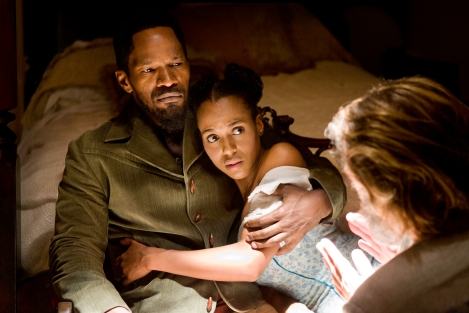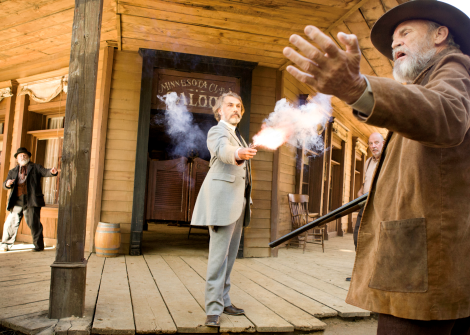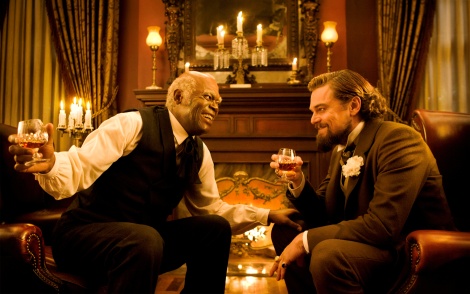This article appeared in the Dec. 19 issue of AwardsLine.
“I think she had to be in there for 20 minutes before I yelled action.”
What Quentin Tarantino is specifically referring to is the time that Kerry Washington spent in the hotbox—a hole in the ground on a plantation where slaves were sent when they tried to escape. It’s where Washington’s character Broomhilda is trapped when her husband, Django (Jamie Foxx), arrives at Candyland—the vast Southern estate owned by her master Calvin Candie (Leonardo DiCaprio) in Tarantino’s Django Unchained. Her voice parched from screaming and her body weakened, Broomhilda doesn’t know that Django has come to rescue her with the help of bounty hunter-cum-dentist Dr. King Schultz (Christoph Waltz).

“Kerry is very game to make things as real as possible,” says Tarantino, who as Waltz points out, can often inspire actors with their characters’ back stories, “Leaving her in the box for 30 seconds and then yelling action wouldn’t work. Nor would sticking her in the box for hours. But 10 minutes in the box could feel like 30. The idea was for Kerry to become disoriented, lose track of time in there, and contemplate what eight hours in the box would feel like. She could yell or scream.”
“But there was a safe word,” adds Washington, “so that the crew knew when I was panicking as a person, and not as an actor. This is how a lot of the film went—taking the reality as far as we could.”
Welcome to Tarantino’s Antebellum South. But instead of the Jewish soldiers bashing in Nazi skulls of Inglourious Basterds, it’s southern slave Django slaying a slew of white devils to get to his bride who has been sold down the river.
We know that Tarantino is the master of cool. But after his boxoffice Oscar breakout Pulp Fiction ($214 million, seven Oscar noms, with an original screenplay win for Tarantino and Roger Avary), he hit a lull. Some of his cinematic homages were relegated to cult status: His double feature with Robert Rodriguez Grindhouse collapsed at $25 million stateside, and the blaxploitation film Jackie Brown made $40 million at the U.S. boxoffice.
What happened? His style hadn’t changed. Tarantino was still the same ultraviolent, cinema vérité absurdist guy, however, he struck a nerve with audiences with his own branded subgenre: The historical wish-fulfillment tale in which the oppressed exact revenge on their oppressors. Basterds minted more than $320 million worldwide; earned eight Oscar noms, including director and picture; and turned unknown Austrian star Waltz into a supporting actor Oscar winner. When news broke in April 2011 that Tarantino was prepping a southern tale much in the same fashion as Basterds, every studio and marquee actor threw their hats in the ring.

“Basterds was something audiences didn’t know that they wanted, and that can be a cool thing—to have something that wasn’t articulated to them before,” assesses Tarantino. “They knew what other World War II movies were like and didn’t want to see the same old tired film again. The same (resonance) could follow through with Django.”
In the same way that Basterds was related to the 1978 Enzo G. Castellari film in title only, so is Django, in regards to the original Sergio Corbucci spaghetti western series (the original Django, actor Franco Nero, makes a cameo opposite Foxx in the film).
“I am only influenced by Corbucci’s oeuvre in terms of the bleak, pitiless, surrealistic west he got across. It wasn’t so much Django itself,” says Tarantino, “As the genre moved on; the name Django became synonymous with all spaghetti westerns. There wasn’t even a character named Django in some of these movies.”
Even though Tarantino turns archetypes on their heads, quite often laced with humor—i.e. Django as the bounty hunter wears a green coat a la Little Joe’s get-up on TV’s Bonanza while a bunch of KKK men clownishly complain that they can’t see through their hoods—the protagonist’s bedrock rests on the life of pre-Civil War African-Americans. Approaching the severity of the material proved to be a grueling dramatic process for the cast.

“I don’t know how anyone lived like this in any real way. We barely made it through for nine months,” Washington explains about the emotional pain of shooting on the Evergreen Plantation outside of New Orleans. “It just added to the resonance of things that we were embodying and portraying these crimes against humanity; that this happened on this sacred ground. There was always this dance between reality and storytelling and the heartache of both.”
To ease the atmosphere during the plantation scenes, Tarantino played gospel music between takes. Nonetheless, the haunting spirits lingered. While preparing for a day’s shoot, Washington remembers trying to take her mind off of one scene by taking in the beautiful trees around her on the plantation grounds. Upon noticing one tree without moss, Washington learned that it was the hanging tree for slaves.
“There were nights when I would text Jamie Foxx at 4 a.m. and say, ‘If this goes on for any longer, I’m not going to make it,’ ” says Washington.
“When you see Leonardo build this eloquent evil character as Calvin Candie, you want to hear those words,” says Foxx about his costar’s racist character, who doles out a monologue on the phrenology of slaves. “Hearing those words, and you hear them enough, it became second hand because that’s how they talked back then. Django is the truest depiction of slavery.”
Partnering Up
Typically, an adult film with a true depiction of slavery, or World War II, might face an uphill battle getting to the big screen. However, Tarantino is in the fortunate position of being able to finish a script, give Harvey Weinstein a call, and the project is fast-tracked from there. A meeting at the director’s house follows, where his friends and the production crew relish a grand reading of his latest work. Sure, having a studio cofinancier such as Columbia Pictures on Django enables Tarantino to get bigger budgets, but the director attributes any higher costs on his films “to moviemaking becoming more expensive. Kill Bill had a huge canvas, but I wanted for nothing.”
Universal coproduced and cofinanced half of Basterds’ $70 million budget, in addition to handling foreign, where they catapulted the film’s overseas boxoffice to $200 million-plus. But despite the studio’s passionate presentation for Django, as reported by Deadline Hollywood, the Weinstein Co. and the producers opted to go with Sony.
“Something spoke to everybody in the room when we met with Sony,” says producer Pilar Savone, who has worked with Tarantino in various capacities across five films since Jackie Brown. Despite Tarantino’s early talks with Will Smith for the role of Django, “partnering with Sony had nothing to do with the studio’s connection to Will Smith,” says Django’s second producer Stacey Sher who first produced with Tarantino on Pulp Fiction.
What is apparent is that Sony has always been passionate about being in business with Tarantino. “I remember talking to Amy Pascal at Sony about Basterds. I told her, ‘I want this movie to be a hit. I don’t want you to do this movie because it’s cool to work with me or for just the cache,’ ” says the director. “And her response to me was, ‘We really want to work with you, and we think this will be your most commercial movie.’ And the same thing with Django, so we’ll see.”
Roles To Kill For
When Smith didn’t commit to the material, Tarantino turned to six other candidates including Idris Elba, Chris Tucker, Terrence Howard, Michael Kenneth Williams, and Tyrese Gibson before settling on Foxx, who won the director over with his Texan roots, cowboy image, and his tolerance of racial issues in the current day South (Foxx even used his own mare Cheetah as his horse Tony). Casting Django was the opposite experience Tarantino faced on Basterds: If he hadn’t found Christoph Waltz to play the multilingual Col. Hans Landa, the director would have been unable to make the movie.
“Quentin was clear with every studio we met with that he wrote the role with no actor in mind. If they did the movie with him, he wasn’t going to cast one actor over another,” says producer Reginald Hudlin who Tarantino first discussed the Django concept with 15 years ago.
“A studio had to be prepared to make the film with an unknown,” adds Sher.
Despite the relentless amount of ink Django received in its casting of Kevin Costner, Anthony LaPaglia, Joseph Gordon-Levitt, and Sacha Baron Cohen, these actors’ inability to commit largely boiled down to scheduling conflicts as Django shot across several locales including New Orleans; Jackson, WY; Mammoth Mountain, CA; Big Sky Studios in Simi Valley, CA; and the Melody Ranch in Santa Clarita, CA. Costner was originally slotted to play Ace Woody, a Mandingo trainer at Candyland, while Cohen was to play a poker player Scotty who loses his slave Broomhilda to Candie. Initially, Jonah Hill was unable to commit, however, his schedule opened up, and he makes a cameo as one of Big Daddy’s (Don Johnson) KKK men.
“We had huge movie stars wanting to do day-player parts,” says Sher, “These actors are typically number one on the call sheet, so everyone schedules around them. But because of everyone else’s schedule and because of snow and weather, we couldn’t accommodate everyone.”
While Django was overlooked by the Screen Actors Guild Awards, the Hollywood Foreign Press embraced DiCaprio’s performance with a supporting actor nod along with Christoph Waltz as well as three other noms for best drama, director, and screenplay.
And with voter audiences having as much fun at Django as they did with Basterds, all this steam begs the question, does Tarantino has a sequel in mind?
“After shooting for nine months and editing for 12 weeks and going on this Mount Everest press tour, I can’t imagine going back,” exclaims Tarantino. “But there’s a story to be told there: Django and Broomhilda still have to get out of the south.”

